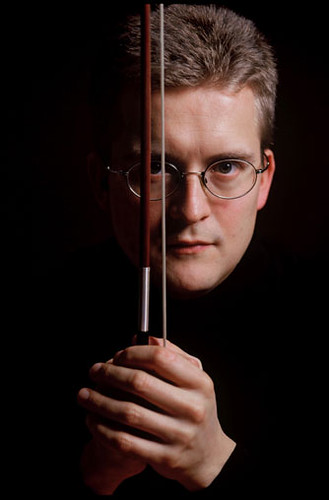Racing to Chicago, Tetzlaff puts individual stamp on Bach violin marathon

The 26.2-mile lakefront run wasn’t the only marathon taking place in Chicago Sunday afternoon. For the first Symphony Center Presents event of the season, Christian Tetzlaff served up Johann Sebastian Bach’s complete Sonatas and Partitas for solo violin in a two-hour and forty-minute span.
Tackling all six of Bach’s solo violin works—28 separate movements not counting the Partitas’ doubles—is an impressive feat of stamina under any circumstances, even with Tetzlaff taking an hour break halfway through the linear traversal of BWV 1001-1006. It was also a daunting display of musical recall, with the German violinist playing completely from memory without a score.
But the backstory makes Tetzlaff’s performance even more extraordinary. Tetzlaff accidentally left his passport at the Japanese consulate in Germany, only discovering it was missing when he arrived at the Frankfurt airport. The delay to retrieve it meant he had to take a later flight and Tetzlaff didn’t arrive in Chicago until late Sunday morning, mere hours before his intensely demanding Bach program.
Under those dire circumstances, one has to cut him some slack for the occasional lack of polish Sunday afternoon at Orchestra Hall. Tetzlaff is an artist who brings an unbridled intensity to his live performances, often sacrificing tone quality and precise intonation for the inspiration of the moment, and there were more than a few rough patches over the long haul, exacerbated, no doubt, by the hectic travel.
Tetzlaff, who has recorded these works twice (on the Virgin and Hanssler labels) is a tough Bach player to pigeonhole. He plays with a Rococo restraint—trim and refined in style rather than with boldly projected tone, lithe, springy rhythms and lightly bowed accents. Yet he’s neither a historically minded dogmatist nor a Romantic: his handling of some of Bach’s most expressive movements was rather brusque, as with the Andante of the Second Sonata in A minor, with the violinist stressing the pulsing counterpoint rather than the limpid main theme.
Unlike his immaculate recordings, Tetzlaff belies his appearance as a bespectacled scholarly type by living dangerously in concert, leaning into a phrase here, bending a note there. At times his fast movements were blinding in their whirlwind virtuosity as with the concluding Presto of the Sonata No. 1 in G minor and the dazzling Courante of Partita No. 1.
If there was a disappointment, it came with the mighty Chaconne, the climax to the Partita No. 2 in D minor. While Tetzlaff handled the technical challenges of this expansive movement—the towering summit of solo violin music—skillfully, his lean, technocratic approach seemed to slight some of the music’s grandeur, expressive weight and spirituality.
But apart from some less than sterling moments—the Fuga of the Second Sonata was especially ragged— for the most part Teztlaff’s Bach was consistently compelling and individual, his nervy dance rhythms, impulsive hairpin dynamic turns, and explosive bravura holding the audience’s interest over the long afternoon.
After intermission—and once the Chaconne was out of the way—Tetzlaff seemed to relax a bit and perform with a greater degree of expressive freedom. The Sonata No. 3 in C major received the finest performance of the cycle— with a poised unsentimental Adagio, thrilling Fuga and deep, memorable Largo, delicately shaded and raptly communicative. His almost whimsical riff on the concluding Partita No. 3—-the happiest of the set—made a delightful coda to the afternoon, sending audience members out into the Michigan Avenue chill with some degree of musical warmth.
Posted in Uncategorized


Posted Oct 14, 2009 at 12:02 pm by John Hopfensperger
You are right that his third sonata was the best performed — and stunningly so, as it is by far the hardest. But the chaconne too was fantastic; similar to his studio recording, but more dramatic.